|
 
This building is one of the oldest remaining in our
city. Prefabricated in New Westminster, it was shipped by train
and 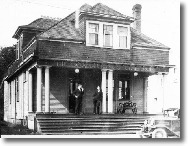 reconstructed
on First Avenue in 1907 as the area's initial Bank of Commerce.
Moved to its present site in 1947, it served as the city's library
until becoming a museum in 1972. Recently restored to its original
appearance, it stands -- with its wooden frame and imposing steps
and columns -- as a small town and west coast version of traditional
banking architecture. reconstructed
on First Avenue in 1907 as the area's initial Bank of Commerce.
Moved to its present site in 1947, it served as the city's library
until becoming a museum in 1972. Recently restored to its original
appearance, it stands -- with its wooden frame and imposing steps
and columns -- as a small town and west coast version of traditional
banking architecture.
 The
Legacy of Anthony Taulbut: Many museum collections
begin with the efforts of an amateur historian to amass and preserve
objects from the past. The collection of Tony Taulbut, which includes
artifacts from nearby and abroad, is now part of the museum's holdings. The
Legacy of Anthony Taulbut: Many museum collections
begin with the efforts of an amateur historian to amass and preserve
objects from the past. The collection of Tony Taulbut, which includes
artifacts from nearby and abroad, is now part of the museum's holdings.
A Man with a Mission: The Legacy of James Welton
Horne: As a land developer and businessman J.W. Horne had erected
the city of Brandon by a railway junction on the Manitoba prairie.
Successful in that endeavor, he considered the importance of the
Mission junction and invested money to develop the downtown area
of what he believed would be another future metropolis. At a much-advertised
"Great Land Sale", he invited settlers to buy into his dream. The
auction was less successful than anticipated, but Horne -- through
a series of clever transactions with a New York company -- managed
to come out on top.
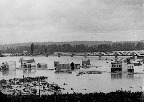 The
Fickle Fraser: Before the completion of good roads, the Fraser
River served as a main transportation route. With paddle wheelers
stopping here on their way between Vancouver and Yale, early Mission
residents benefited from their proximity to the river. Living close
to the Fraser also brought problems, however. More than once, flooding
devastated the area , destroying homes and crops and killing livestock.
At the time of the 1894 flood most of Mission was built on flat
land. After this disaster, most settlers moved up on the hill, but
Chinese residents reclaimed the abandoned flats. Many of them had
come as workers on the railroad and remained in the area earning
lower wages than other residents. A thriving Chinese community developed
with stores, boarding houses, a hotel and apparently even a brothel
until a fire destroyed almost everything in the 1920's The
Fickle Fraser: Before the completion of good roads, the Fraser
River served as a main transportation route. With paddle wheelers
stopping here on their way between Vancouver and Yale, early Mission
residents benefited from their proximity to the river. Living close
to the Fraser also brought problems, however. More than once, flooding
devastated the area , destroying homes and crops and killing livestock.
At the time of the 1894 flood most of Mission was built on flat
land. After this disaster, most settlers moved up on the hill, but
Chinese residents reclaimed the abandoned flats. Many of them had
come as workers on the railroad and remained in the area earning
lower wages than other residents. A thriving Chinese community developed
with stores, boarding houses, a hotel and apparently even a brothel
until a fire destroyed almost everything in the 1920's
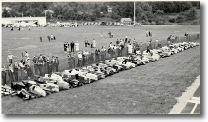 Mission's
Annual Soap Box Derby: In 1946, Mission became one of two
soap box derby competition towns in Canada. Young competitors came Mission's
Annual Soap Box Derby: In 1946, Mission became one of two
soap box derby competition towns in Canada. Young competitors came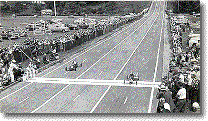 from as far away as the prairies to test the speed of their homemade
cars, which the rules stated had to be built completely by the boy
without adult assistance. The Mission derby remained a popular event
until its demise in 1974.
from as far away as the prairies to test the speed of their homemade
cars, which the rules stated had to be built completely by the boy
without adult assistance. The Mission derby remained a popular event
until its demise in 1974.
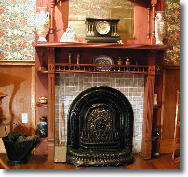
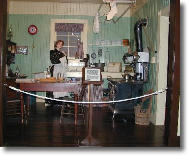 The
1920's Kitchen and Parlor: Arranged for practicality and convenience,
the 1920's Kitchen had a vast assortment of Kitchen gadgets. Most
of the gadgets were made of lightweight, easy to clean materials
that became available and popular during these years. The advent
of electricity also introduced new appliances such as toasters and
irons. The kitchen was the focal point for families in most homes.
The Mantel and Fire Place in the Parlor came from the house of Anthony
Taulbut, the Museum's greatest benefactor. These two permanent exhibits
are an attempt to show what life would have looked like years ago. The
1920's Kitchen and Parlor: Arranged for practicality and convenience,
the 1920's Kitchen had a vast assortment of Kitchen gadgets. Most
of the gadgets were made of lightweight, easy to clean materials
that became available and popular during these years. The advent
of electricity also introduced new appliances such as toasters and
irons. The kitchen was the focal point for families in most homes.
The Mantel and Fire Place in the Parlor came from the house of Anthony
Taulbut, the Museum's greatest benefactor. These two permanent exhibits
are an attempt to show what life would have looked like years ago.
 Lumber
Industry in Early Mission: In the early 1880's most of the area's
logging operators were located within reach of local rivers and
produced ties and sleepers for the railroad. In 1898, E. H. Heaps
& Sons took over operation of the failed sawmill operation of
John Ruskin on the Stave River. In 1892 John B. Cade had a steam
powered tie mill in the Ferndale area. George Taggert produced ties
and dressed lumber at his mill in Silverdale from 1893-1896. In
1916 two new operations were established: Stoltz Shingle Mill at
Ruskin and Jesse James Logging Co. at Steelhead near Stave Falls.
From that time forward, the shake and shingle industry became very
significant to the economy of Mission. Lumber
Industry in Early Mission: In the early 1880's most of the area's
logging operators were located within reach of local rivers and
produced ties and sleepers for the railroad. In 1898, E. H. Heaps
& Sons took over operation of the failed sawmill operation of
John Ruskin on the Stave River. In 1892 John B. Cade had a steam
powered tie mill in the Ferndale area. George Taggert produced ties
and dressed lumber at his mill in Silverdale from 1893-1896. In
1916 two new operations were established: Stoltz Shingle Mill at
Ruskin and Jesse James Logging Co. at Steelhead near Stave Falls.
From that time forward, the shake and shingle industry became very
significant to the economy of Mission.
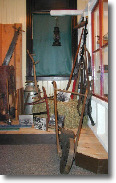 Life
on the Farm: Many homesteaders grew their own fruits and vegetables
and kept a cow and horse for their family needs; but Mission's fertile
land soon attracted commercial farming ventures. Many of the most
successful farmers were Japanese settlers who harvested strawberries
on Mission's steep hills. When the Japanese were interred during
the Second World War, Mission's reputation as "Strawberry Capital
of the World" slowly went into decline. Life
on the Farm: Many homesteaders grew their own fruits and vegetables
and kept a cow and horse for their family needs; but Mission's fertile
land soon attracted commercial farming ventures. Many of the most
successful farmers were Japanese settlers who harvested strawberries
on Mission's steep hills. When the Japanese were interred during
the Second World War, Mission's reputation as "Strawberry Capital
of the World" slowly went into decline.
Archive images courtesy of the Mission Community Archives
About the Museum - Soap
Box Derby - General Tour
Local History - Teachers
Corner
|










